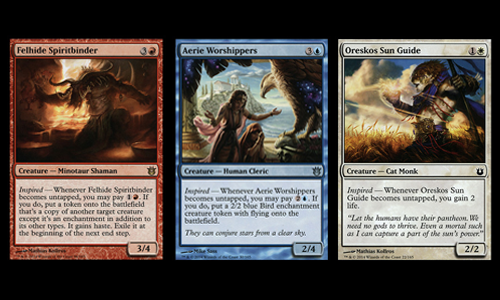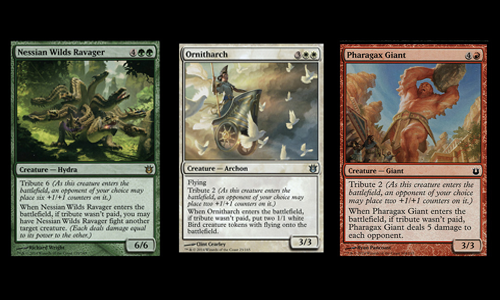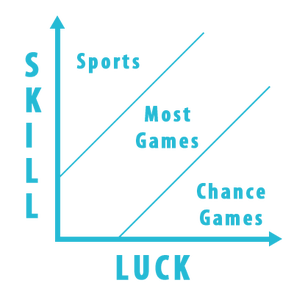It has been a while since the Magic: the Gathering's set Born of the Gods (BNG) has been out in the public and, while I've been itching to write about it, I wanted to wait for the next set to come out to get a better view of how BNG fits within the Theros block.
For those who are unfamiliar with Magic's formula, here's an abridged explanation. At the Fall of every year, Magic releases a new "Block" which is usually divided into three "Sets" . Each Block is set in either a new or previously visited world that ties in all cards and narrative. Each Set also contains a handful of brand new mechanics meant to spice up the game while also embodying the themes of the Block.
Born of the Gods is the second Set of the Theros Block, a top-down designed world inspired by Greek mythology with a clear Magic spin to it. The focus of the Block lies on the interaction between Gods, Heroes and Monsters and the heavy use of enchantments is used to allude to domains and favors of the Gods.
Let's take a look at critical look at the two mechanics introduced in BNG:
Inspired
For those who are unfamiliar with Magic's formula, here's an abridged explanation. At the Fall of every year, Magic releases a new "Block" which is usually divided into three "Sets" . Each Block is set in either a new or previously visited world that ties in all cards and narrative. Each Set also contains a handful of brand new mechanics meant to spice up the game while also embodying the themes of the Block.
Born of the Gods is the second Set of the Theros Block, a top-down designed world inspired by Greek mythology with a clear Magic spin to it. The focus of the Block lies on the interaction between Gods, Heroes and Monsters and the heavy use of enchantments is used to allude to domains and favors of the Gods.
Let's take a look at critical look at the two mechanics introduced in BNG:
Inspired
Ironically, "Inspired" is the least inspired mechanic Magic has featured in a few years. It favors creatures that are generally aggressive and that a player would want to attack with. The problem is that it is frequently featured on creatures that are meant to be played defensively, jeopardizing the player's ability to make it trigger.
Another problem with Inspired is tempo investment that it requires. When you play an inspired creature you'll have to wait until next turn to attack and only on the third turn will you finally get the trigger. Moreover, Inspired often inquires additional costs for its activation, and because it almost always triggers during the untap step, it forces players to commit to it before they have the chance to draw their card of the turn and plan out their strategy accurately.
The flavor behind Inspired was that the creature would draw powers from the world of dreams; the untapping represents the creature waking up and being able to use the power it acquired while sleeping. Not only the flavor is very loosely connected to the world of Theros, it is also very hard to understand it without someone just outright telling you what it is.
In conclusion, Inspired ranks low on both gameplay value as well as flavor and is possibly one of the weakest mechanics designed in the last five years of Magic.
Tribute
Another problem with Inspired is tempo investment that it requires. When you play an inspired creature you'll have to wait until next turn to attack and only on the third turn will you finally get the trigger. Moreover, Inspired often inquires additional costs for its activation, and because it almost always triggers during the untap step, it forces players to commit to it before they have the chance to draw their card of the turn and plan out their strategy accurately.
The flavor behind Inspired was that the creature would draw powers from the world of dreams; the untapping represents the creature waking up and being able to use the power it acquired while sleeping. Not only the flavor is very loosely connected to the world of Theros, it is also very hard to understand it without someone just outright telling you what it is.
In conclusion, Inspired ranks low on both gameplay value as well as flavor and is possibly one of the weakest mechanics designed in the last five years of Magic.
Tribute
Tribute was the monster-related mechanic chosen for BNG. It followed on the footsteps of the widely popular Monstrosity mechanic which, in my opinion, was better designed in both gameplay and flavor. Tribute shows up exclusively on creatures and pushes your opponent to make a choice of whether to allow you to have a bigger creature or to gain some other effect instead.
Gameplay-wise this often creates a feel bad moment for the player casting a creature with Tribute. On a surface level it might seem that you'll get one of either two good effects when, in reality, you'll always gain the worst of the two for any given situation. Sure, it would be nice to cast a 6 mana 12/12 but it will never happen unless your opponent has a way to deal with it in his hand or board.
Ironically, the best of the Tribute creatures are the ones that feature similar effects no matter what choice your opponent makes. If that sounded weird to you, welcome to the club; as opposed to enable variety as the original design intended for, it fuels the opposite behavior. It was not a surprise when the designers chose to ditch this mechanic and bring back Monstrosity later in the third Set.
Card Review
While Born of the Gods only introduced these two new mechanics, it did bring back earlier well received mechanics from Theros such as Heroic, Devotion, Bestow and Scry. The best designed cards in BNG expand and continue the exploration of the design space set forth by its predecessor and it was clear that some of the good ideas that didn't fit into Theros were explored here.
As far as the competitive scene goes, here too Born of the Gods fell short in delivering a good selection of new cards to excite players and had a surprisingly little splash on Standard and Modern with only a few cards seeing competitive play:
-Bile Blight: an uncommon removal that proved to be useful in dealing with pesky Pack Rats. It is very likely that this card was created solely for balance reasons as it doesn't seem to fit Theros particularly well unlike most of the other spells in the Block.
-Brimaz, King of Oreskos: a continuation on the trend of pushing creatures to the limit. Brimaz doesn't feature any of the new block's mechanics but packs in raw power and low cost. Nothing about him is particular characteristic of Theros which makes it a let down that the most memorable card of the set could have been featured in nearly any other Block.
-Courser of Kruphix: offers some decent card advantage in green with some nice incidental lifegain and is also an enchantment to trigger constellation. Combined with its pretty good defensive stats it will likely be a staple throughout its stay in standard.
-Mogis and Xenagos: have seen some competitive play but whose merits are split between the Devotion and God mechanics, both of which were introduced in Theros.
Conclusion
Among color and rarity imbalances, two poorly designed mechanics that fail at both flavor and gameplay and being part of the trend that the second Set on a Large, Small, Small Block structure often feature lackluster designs; Born of the Gods gets my rank of worst designed set since Eventide.
Hopefully, Wizards of the Coast will look back to this point and realize that the second Set in the Block has to carry a lot more weight and help tie the block mechanics together rather than just being a pile of new cards with random mechanics that are all bound purely by flavor.
Either that or they should completely restructure their approaches to sets and blocks. Most players would agree that the best draft experiences are often the triple of the same set (i.e: THS-THS-THS) since it lets the set mechanics shine more, I wouldn't mind if they restructured their releases to have just two or even one large set with each release, similarly to what is done in core sets but with the nice flavor and mechanics package that we all love MtG for.
Gameplay-wise this often creates a feel bad moment for the player casting a creature with Tribute. On a surface level it might seem that you'll get one of either two good effects when, in reality, you'll always gain the worst of the two for any given situation. Sure, it would be nice to cast a 6 mana 12/12 but it will never happen unless your opponent has a way to deal with it in his hand or board.
Ironically, the best of the Tribute creatures are the ones that feature similar effects no matter what choice your opponent makes. If that sounded weird to you, welcome to the club; as opposed to enable variety as the original design intended for, it fuels the opposite behavior. It was not a surprise when the designers chose to ditch this mechanic and bring back Monstrosity later in the third Set.
Card Review
While Born of the Gods only introduced these two new mechanics, it did bring back earlier well received mechanics from Theros such as Heroic, Devotion, Bestow and Scry. The best designed cards in BNG expand and continue the exploration of the design space set forth by its predecessor and it was clear that some of the good ideas that didn't fit into Theros were explored here.
As far as the competitive scene goes, here too Born of the Gods fell short in delivering a good selection of new cards to excite players and had a surprisingly little splash on Standard and Modern with only a few cards seeing competitive play:
-Bile Blight: an uncommon removal that proved to be useful in dealing with pesky Pack Rats. It is very likely that this card was created solely for balance reasons as it doesn't seem to fit Theros particularly well unlike most of the other spells in the Block.
-Brimaz, King of Oreskos: a continuation on the trend of pushing creatures to the limit. Brimaz doesn't feature any of the new block's mechanics but packs in raw power and low cost. Nothing about him is particular characteristic of Theros which makes it a let down that the most memorable card of the set could have been featured in nearly any other Block.
-Courser of Kruphix: offers some decent card advantage in green with some nice incidental lifegain and is also an enchantment to trigger constellation. Combined with its pretty good defensive stats it will likely be a staple throughout its stay in standard.
-Mogis and Xenagos: have seen some competitive play but whose merits are split between the Devotion and God mechanics, both of which were introduced in Theros.
Conclusion
Among color and rarity imbalances, two poorly designed mechanics that fail at both flavor and gameplay and being part of the trend that the second Set on a Large, Small, Small Block structure often feature lackluster designs; Born of the Gods gets my rank of worst designed set since Eventide.
Hopefully, Wizards of the Coast will look back to this point and realize that the second Set in the Block has to carry a lot more weight and help tie the block mechanics together rather than just being a pile of new cards with random mechanics that are all bound purely by flavor.
Either that or they should completely restructure their approaches to sets and blocks. Most players would agree that the best draft experiences are often the triple of the same set (i.e: THS-THS-THS) since it lets the set mechanics shine more, I wouldn't mind if they restructured their releases to have just two or even one large set with each release, similarly to what is done in core sets but with the nice flavor and mechanics package that we all love MtG for.





 RSS Feed
RSS Feed